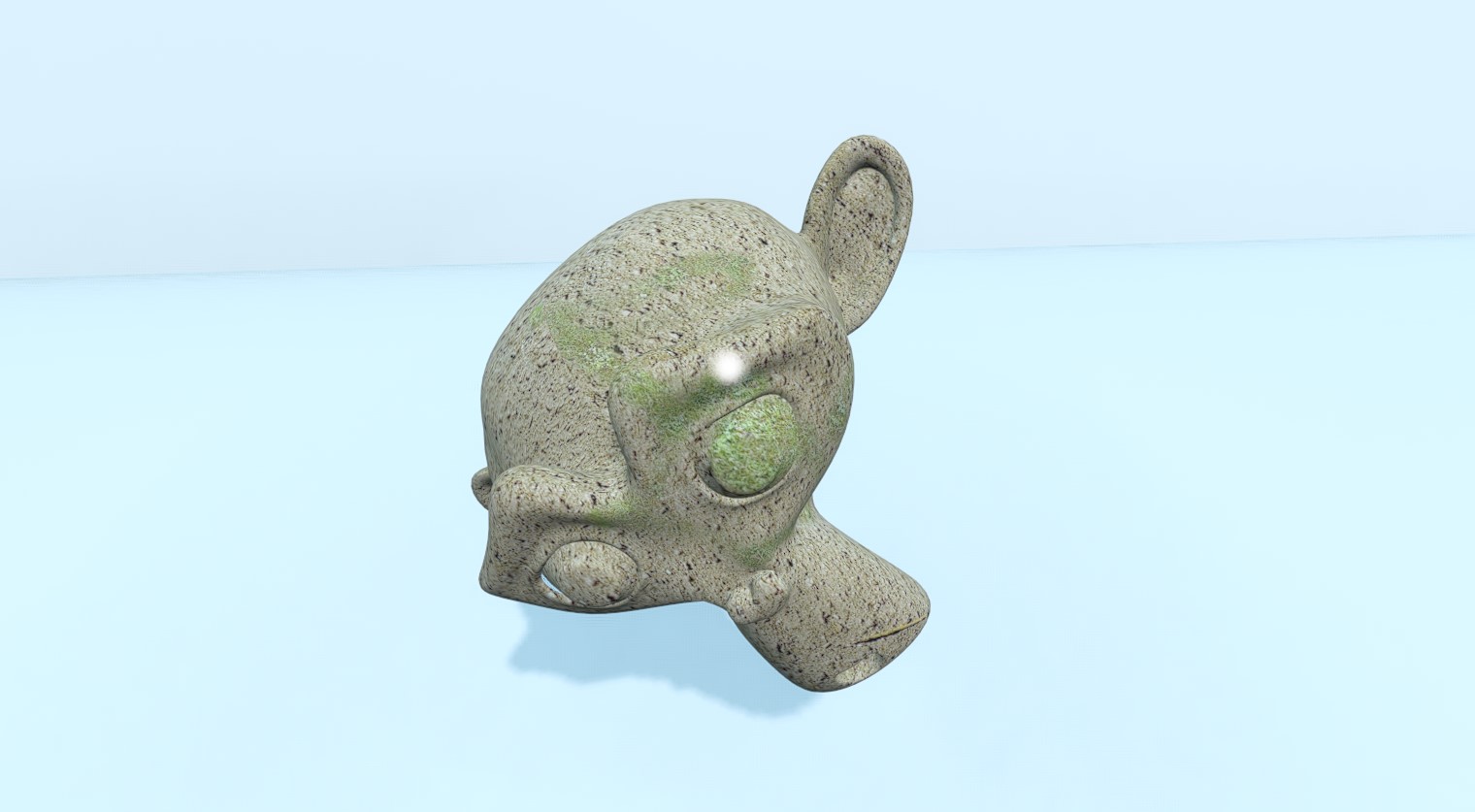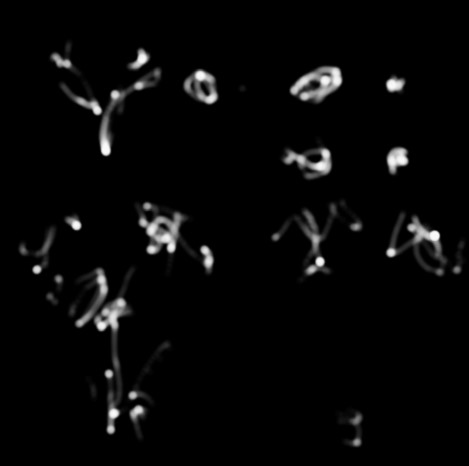This is my solution to perform runtime Texture Painting, in order to paint a splat map in-game with the Godot Engine. My initial objective was to accomplish a Car Wash effect, i.e. remove a dirt texture that is overlaid on top of the car mesh’s texture. But the final implementation can be used in many different scenarios and effects, such as:
- Actual painting something in game
- Terrain and mesh deformation
- Anything else you can imagine by blending textures. Because it’s just a matter of interpolating the painted textures with anything else with shaders (sample shader included here).
Download the source-code and sample project from my Github (you can walk in the world with WASD and to paint click and drag with the left mouse button). My journey in order to find the final solution is documented in the Godot Forums.
Features
- Any kind of brush
- Multiple brushes
- Multiple splat maps and multiple textures blended
- Mesh can be anywhere in the world and can be rotated
World Position to UV
The first and most important step is to map a World Vector3 Position to a Mesh UV Position, in order to map the raycast from the current position the camera is looking at to the precise texture coordinate of the mesh.
This is easily accomplished in Unity with RaycastHit.textureCoord and in Unreal Engine with Find Collision UV.
Unfortunately Godot does not provide any built-in mechanism to map a world position to UV, which led me to implement my own solution with GDScript to accomplish that.
GDScript Get UV Coordinates from Vector3
The solution I found with Godot involves loading the Mesh vertices and normals with MeshDataTool, and then using Barycentric Coordinates to find the UV from a Vector3.
The final code is heavily adapted from this Godot 2 repository from 2017 by Daniel Byron. I also got the Barycentric calculation function from Arnklit’s Waterways Godot Plugin.
Since Daniel’s code works only with meshes at the world origin (Vector3(0,0,0)) and it regenerates the Mesh Data any time you need to find the UV), I improved it to make it work at runtime, with a mesh in any position in the world, as well I cache the vertex data and of course, I made it work with Godot 3.
Code – UVPosition.gd
extends Node var meshtool var mesh var mesh_instance var transform_vertex_to_global = true var _face_count := 0 var _world_normals := PoolVector3Array() var _world_vertices := [] var _local_face_vertices := [] func set_mesh(_mesh_instance): mesh_instance = _mesh_instance mesh = _mesh_instance.mesh meshtool = MeshDataTool.new() meshtool.create_from_surface(mesh, 0) _face_count = meshtool.get_face_count() _world_normals.resize(_face_count) _load_mesh_data() func _resize_pools(): pass func _load_mesh_data(): for idx in range(_face_count): _world_normals[idx] = mesh_instance.global_transform.basis.xform(meshtool.get_face_normal(idx)) var fv1 = meshtool.get_face_vertex(idx, 0) var fv2 = meshtool.get_face_vertex(idx, 1) var fv3 = meshtool.get_face_vertex(idx, 2) _local_face_vertices.append([fv1, fv2, fv3]) _world_vertices.append([ mesh_instance.global_transform.xform(meshtool.get_vertex(fv1)), mesh_instance.global_transform.xform(meshtool.get_vertex(fv2)), mesh_instance.global_transform.xform(meshtool.get_vertex(fv3)), ]) func get_face(point, normal, epsilon = 0.2): for idx in range(_face_count): var world_normal = _world_normals[idx] if !equals_with_epsilon(world_normal, normal, epsilon): continue var vertices = _world_vertices[idx] var bc = is_point_in_triangle(point, vertices[0], vertices[1], vertices[2]) if bc: return [idx, vertices, bc] return null func get_uv_coords(point, normal, transform = true): # Gets the uv coordinates on the mesh given a point on the mesh and normal # these values can be obtained from a raycast transform_vertex_to_global = transform var face = get_face(point, normal) if face == null: return null var bc = face[2] # var uv1 = meshtool.get_vertex_uv(_local_face_vertices[face[0]][0]) var uv2 = meshtool.get_vertex_uv(_local_face_vertices[face[0]][1]) var uv3 = meshtool.get_vertex_uv(_local_face_vertices[face[0]][2]) return (uv1 * bc.x) + (uv2 * bc.y) + (uv3 * bc.z) func equals_with_epsilon(v1, v2, epsilon): if (v1.distance_to(v2) < epsilon): return true return false func cart2bary(p : Vector3, a : Vector3, b : Vector3, c: Vector3) -> Vector3: var v0 := b - a var v1 := c - a var v2 := p - a var d00 := v0.dot(v0) var d01 := v0.dot(v1) var d11 := v1.dot(v1) var d20 := v2.dot(v0) var d21 := v2.dot(v1) var denom := d00 * d11 - d01 * d01 var v = (d11 * d20 - d01 * d21) / denom var w = (d00 * d21 - d01 * d20) / denom var u = 1.0 - v - w return Vector3(u, v, w) func transfer_point(from : Basis, to : Basis, point : Vector3) -> Vector3: return (to * from.inverse()).xform(point) func bary2cart(a : Vector3, b : Vector3, c: Vector3, barycentric: Vector3) -> Vector3: return barycentric.x * a + barycentric.y * b + barycentric.z * c func is_point_in_triangle(point, v1, v2, v3): var bc = cart2bary(point, v1, v2, v3) if (bc.x < 0 or bc.x > 1) or (bc.y < 0 or bc.y > 1) or (bc.z < 0 or bc.z > 1): return null return bc
Coffee, Coins and Follows
If you like my content or if you learned something from it, buy me a coffee ☕, be my Patreon or simply check all of my links 🔗 and follow me/subscribe/star my repositories/whatever you prefer. If you want to learn Godot, be sure to check my courses 📚!
Or you can simply add my game to your Steam Wishlist – that helps GREATLY and it’s easy and free 🙂
Dynamic Texture Render Target (Viewport)
The runtime paint strokes (or hits) are saved in a dynamic viewport texture.
Those are my settings:

And it has the following script attached (DrawViewport.gd):
extends Viewport onready var brush = $Brush func move_brush(position : Vector2): set_update_mode(UPDATE_ONCE) brush.set_position(position) func brush_size(): return brush.texture.get_height()
As a child of the Viewport add a Sprite with the brush as texture.
Mesh Setup
- Must have a collider.
- Shader which blends the Mesh main textures, with the Dirt/Damage textures and the splat map texture.
- If the mesh is high poly it’s a must to have a very low-poly LOD to serve as the collider and to have the World to UV mapping, otherwise performance will be degraded (check the example project to see how I have done this).

Registering Paint Hits in the Render Target with Raycasts
Place a script in a Spatial Node anywhere in a Scene that has the Viewport Render Target, then assign the Viewport Texture to the SplatMapTexture of the above shader.
Example: material.set_shader_param("SplatMapTexture", viewport0.get_texture())
Then, cast a ray, get the UV coordinates with get_uv_coords and move the viewport brush sprite:
if result.size() > 0:
var uv = uv_positions.get_uv_coords(result.position, result.normal, true)
if uv:
get("viewport" + str(ray_idx)).move_brush(uv * tex_size)
And this is it! The splat map is drawn and since it’s interpolated into the mesh’s material, you are going to see the results immediately.
Source-code and Sample Project
The Godot 3 sample project and source-code is available on my Github.



